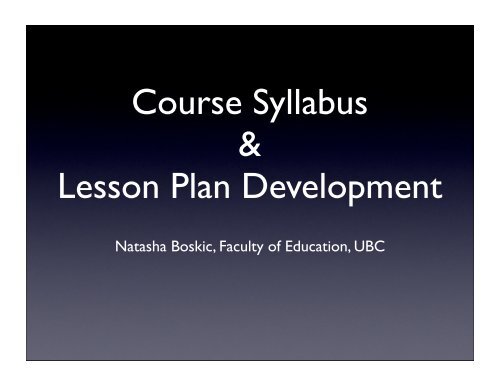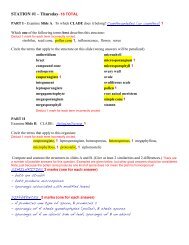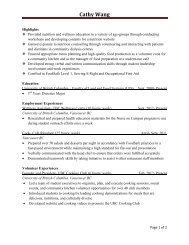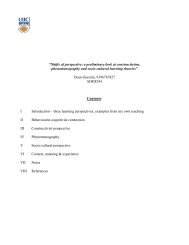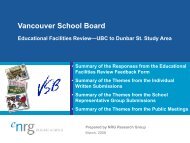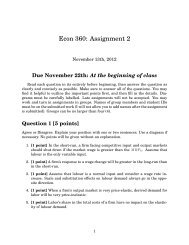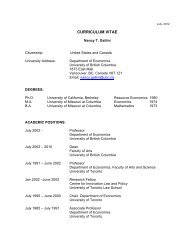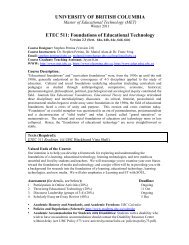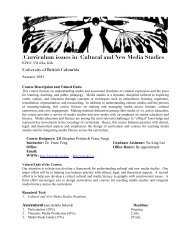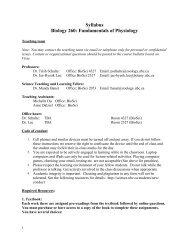Syllabus and Lesson Plan Development - UBC Blogs
Syllabus and Lesson Plan Development - UBC Blogs
Syllabus and Lesson Plan Development - UBC Blogs
- No tags were found...
Create successful ePaper yourself
Turn your PDF publications into a flip-book with our unique Google optimized e-Paper software.
Course <strong>Syllabus</strong>&<strong>Lesson</strong> <strong>Plan</strong> <strong>Development</strong>Natasha Boskic, Faculty of Education, <strong>UBC</strong>
Ideas• Students <strong>and</strong> their ability tolearn are the center of what wedo• We focus on the process oflearning rather than thecontentThe content <strong>and</strong> the teacher adapt to the students rather than expectingthe students to adapt to the contentResponsibility is placed on students to learn rather than on professors toteach
Big QuestionsWhyWhatWhoHowwe teach?
More questions• What is our teaching philosophy?• How do we organize knowledge?• With what theoretical questions are wemost concerned?• How do we apply what we know?• What stimulate our enthusiasm?http://www.flickr.com/photos/paurian/3707187124/
About the Learners• How do we encourage responsibility forlearning, so that the students are able to:• Critique different sources ofinformation• Synthesize different information• Assess information sourceshttp://www.flickr.com/photos/benchilada/4125134199/http://www.flickr.com/photos/benchilada/4125137187/
Moveinstructor-leadapproachStudent-initiatedapproach• Participate in planning the coursecontent <strong>and</strong> activities• Clarify their own goals <strong>and</strong> objectives• Monitor <strong>and</strong> assess their own progress• Establish criteria for judging their wonperformance
Thinking about it• Anticipate the questions (assignments,policies, schedule, prerequisites)• Be flexiblehttp://www.flickr.com/photos/vee_smith/3784931775/
Your turnList all the items/componentsyou would include into yoursyllabus
Writing the <strong>Syllabus</strong>...• Include more, reduceanxiety• include all basicinformation• prerequisites• course purpose (how itfits into the curriculum)• what the course doesnot address• Provide clear outcomes
...continued 2...• explain the conceptual structure of thecourse• format of the course• Define instructor’s <strong>and</strong> students’responsibilities• Establish ways of communication• What is required vs. optional
...continued 3...• Textbooks <strong>and</strong> readings (Providereading materials)• Clarify student workload• Assignments, projects, papers,exams (dates, performancecriteria)• Establish st<strong>and</strong>ards <strong>and</strong>procedures for evaluation• Grading criteria, rubrics• Additional equipment or materials
...continued 4• Students with special needs• Schedule time for student feedback on thecourse• Course calendar• Important dates• Policies• Available help (from theglossary of terms to sampleassignments)
Distribution of the• The first class of thecourse<strong>Syllabus</strong>• If revised, distribute againthe updated copy• Few extra copies•Publish your syllabusonline
Developing a <strong>Lesson</strong> <strong>Plan</strong>
<strong>Lesson</strong> <strong>Plan</strong> ModelsDepends on your teaching strategy• Pratt’s five learning models• The transmission perspective• The apprenticeship perspective• The developmental perspective• The nurturing perspective• The social reform perspective
The Transmission PerspectiveThe strongest relationship isbetween the Teacher <strong>and</strong> theContent, depicted with a solidline. The teaching processbegins with the Teacher, movesthrough the Content <strong>and</strong> on tothe Learners.Teacher• Cover the content• Present it efficientlyLearner• Master the content (recall from memory• Little or no interaction
The Collaborative PerspectiveThe strongest relationship inthis perspective is betweenthe Learners <strong>and</strong> theContent. The teaching processbegins with the Teacher <strong>and</strong>moves through the Learnersto the Content.Teacher• Effective questioning• Bridging knowledgeLearner• Construct his/her knowledge• Collaborative learning
Zone of Proximal <strong>Development</strong>• Think about this idea for a moment.There is an area where students cangrow in their learning, progressing fromneeding someone show them what todo, to needing someone to work withthem, to only needing a bit ofsupervision, to being able to use the skillor accomplish the task on their own.
Models of Mind
Models of MindLearning as informa-on processingLearning as experien-al growth Learning as social, dialogical process Effec-ve communica-on / recall of informa-onIndividual development of appropriate cogni-ve mapsEmbed learning in authen-c tasks leading to communi-es of prac-ceTransmission ApproachNurturing/<strong>Development</strong>al ApproachCollabora-ve Approach
Your turn- Think about one or two pointsthat makes your lesson planningdifficult. Write it down.- Think about one or two pointsthat makes you excited aboutyour course. Write it down.
<strong>Lesson</strong> <strong>Plan</strong>Castle Top DiagramFink, D. (2003). Creating Significant Learning Experience.
<strong>Plan</strong>ning the Whole Course
<strong>Lesson</strong> <strong>Plan</strong> Template• Title• Specific topic to teach• General goals ---> specificobjectives• Required materials• Ice-breaker, hook• Step-by-step procedures<strong>Plan</strong> for independent practiceAssessment (based on theobjectives)Contingency plan (forstruggling or gifted students)ClosureReflection
Engagement StrategiesStart with first session or lecture• • Norms <strong>and</strong> expectations are establishedIf not, explain change in norms when you doBegin session with a "bridge" <strong>and</strong> a "hook"• • • • • Two-minute summary of last sessionPose a question, problem, case, story, or issueSolicit variety of tentative answersAsk learners to list their questionsUse these as you introduce new material or newways of thinkingKeep an engaging <strong>and</strong> safe atmosphere• Avoid criticism of questions or comments• Use 'warm' rather than 'cold' questions• Invite challenge to ideas (yours <strong>and</strong> others)• Punctuate lectures with questions• Pause after making a major point• Pose a question related to the point• Ask for a vote on possible interpretations• Ask for raise of h<strong>and</strong>s• Insert a multiple-choice question• Invite someone else to explain (for 2 minutes)When using slides, tables, graphs, h<strong>and</strong>outs• • • Ask what they see before explaining it to themAsk what questions they would ask of the dataLet them be colleagues, co-investigators or problemsolverswith the materialVary the format• Use debates, role-plays, panels, guests• Divide into small groups, each taking a positionStop the lecture <strong>and</strong> have audience write for 2 minuteson a question related to the presentation• Follow-up with group discussions of theirsummaries• Have learners go to board to present small groupconsensusClosing the lecture• • • • • • • Allow time for questions, points of clarificationCome early or stay after to talk with peopleEnd with provocative question(s)Give a single-question 'quiz' based on lectureLeave room <strong>and</strong> let them discuss the questionReturn <strong>and</strong> hear their resultsUse a one-minute paper to have them summarize• Main point of the session• Main question they still have
Questions for Reflection• Can a successful method be successful for all?• The importance of contextIndividual philosophy ofteaching
Closure• What was the mostimportant thing youlearned during thissession?• What importantquestions remainedunanswered?


